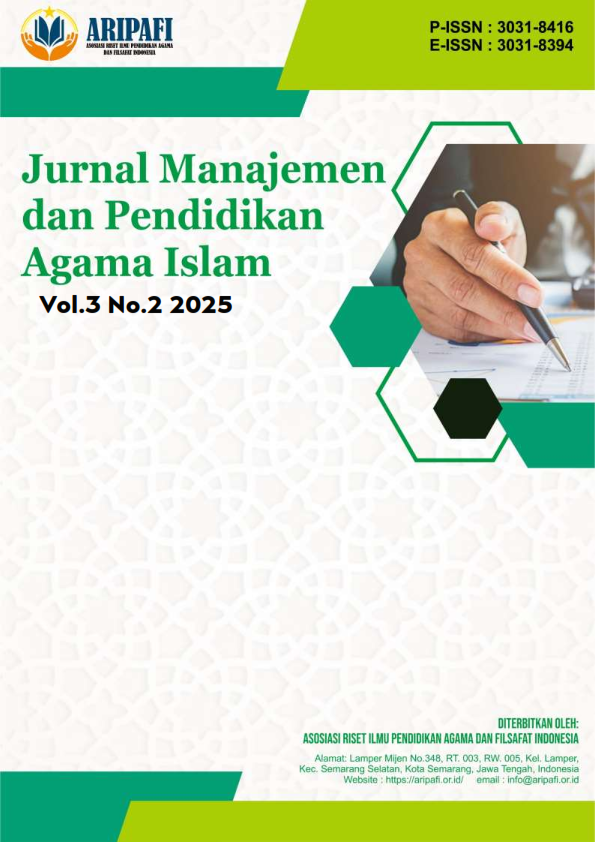Mengenal Keindahan Susunan Bahasa Al-Qur’an Melalui Al-Istikhdam dan Al-Istithrad
DOI:
https://doi.org/10.61132/jmpai.v3i2.981Keywords:
Al-Istikhdam, Al-Istithrad, Balaghah, Arabic Rhetoric, Textual AnalysisAbstract
This study explores the concepts of Al-Istikhdam and Al-Istithrad as part of stylistic devices in the Arabic rhetoric discipline (balaghah). Al-Istikhdam refers to the use of a single word with two different meanings in a specific context, while Al-Istithrad involves the insertion of additional sentences or ideas without deviating from the main discussion. The study aims to identify the application of these two concepts in classical Arabic texts, particularly in literary and rhetorical works. The method employed is textual analysis of primary sources such as the Qur'an, hadith, and classical poetry. The findings reveal that Al-Istikhdam is used to enrich meanings and refine stylistic expression, whereas Al-Istithrad functions to provide additional explanations that strengthen the main argument without disrupting narrative flow. This research is expected to offer new insights into the beauty and complexity of the Arabic language and its contribution to the development of balaghah studies.
Downloads
References
Aman, M. (2021). Bahasa Arab Dan Bahasa Al-Qur’an. Jurnal Kajian Islam Dan Pendidikan Tadarus Tarbawy, 3(1). https://doi.org/10.31000/jkip.v3i1.4256
Asy’ari, H. (2012). keistimewaan bahasa arab sebagai bahasa al qur’an. Nidhomul Haq: Jurnal Manajemen Pendidikan Islam, 1(1), 1–28.
Azizah, N. H. (2017). Istidrāj Dalam Al- Qur ’ Ān. In Istidrāj Dalam Al-Qur’Ān ( Analisis Ayat-Ayat Tentang Istidrāj) (Vol. 7). Universitas Islam Negeri Syarif Hidayatullah.
Daflani. (2000). Buku Ajar Ulumul Qur ’ an. 125.
Dedy Wahyudin, & Djuaini. (2019). Keutuhan nada dan makna dalam susunan bahasa Al-Quran. El-Tsaqafah Jurnal Jurusan PBA, 18(1), 66–83.
Habib. (2003). gaya bahasa al-quran: Daya Tarik al-Qur ’ an Dari Aspek Bahasa. Adabiyyat, 1(2), 61–67.
Metro, J. S. (2013). Ulum al-qur’an.
Nurdiyanto, A. (2016). Istifham Dalam Al-Qur’an: Studi Analisa Balaghah. El-Wasathiya: Jurnal Studi Agama, 4(1), 39–52.
Rahmad. (2009). Tajahul Al-Arif dalam Al-qur’an. 66–85.
Ramadhani, L. M., & Ishaac, M. (2023). Telaah Perangkat Dan Makna Istifham Dalam Al-Qur’an Perspektif Moralitas Dan Teologi Islam Kontemporer. AL-MUHITH, 2(1), 45–60.
Rasyid, H. Al. (2024). Analisis Istifham Dalam Qs . Al-Baqarah 258 ( Studi Analisis Balaghah ). 4, 18108–18120.
Saleh, S. (2016). Muhassinat Ma’nawiyyah dalam Sya’ir (Studi Analisis Ilmu Badi’). Al-’AJAMI: Jurnal Bahasa Dan Sastra Arab, 5(1), 31–53.
Umroh, I. L. (2019). Keindahan Bahasa Al-Qur’an Dan Pengaruhnya Terhadap Bahasa Dan Sastra Arab Jahily. 49–65.
Yani, F., Faizah, F., & Sholehah, D. (2022). Mengenal Al-Munasabah. MUSHAF JOURNAL: Jurnal Ilmu Al Quran Dan Hadis, 2(1), 79–92. https://doi.org/10.54443/mushaf.v2i1.21
Yusuf, M. S. (2019). Penggunaan Ilmu Munâsabah dalam Istinbâth Hukum. Tajdid, 26(2), 117. https://doi.org/10.36667/tajdid.v26i2.332
Downloads
Published
How to Cite
Issue
Section
License
Copyright (c) 2025 Jurnal Manajemen dan Pendidikan Agama Islam

This work is licensed under a Creative Commons Attribution-ShareAlike 4.0 International License.





